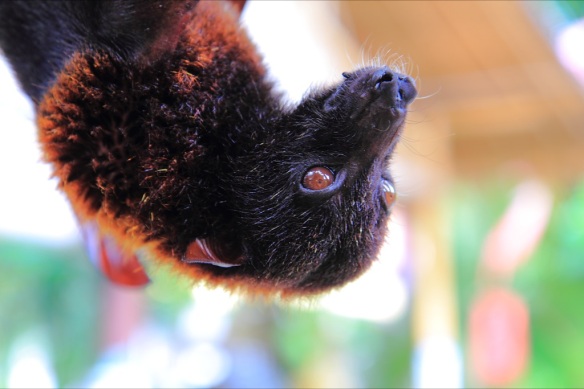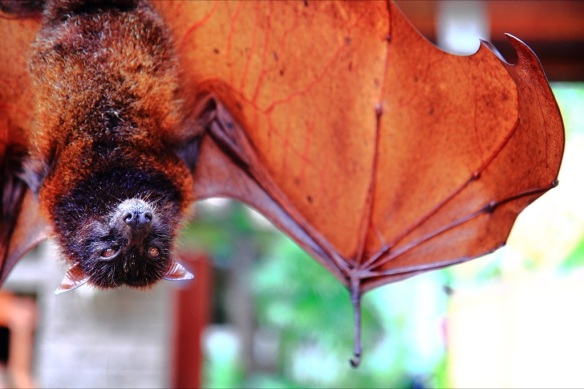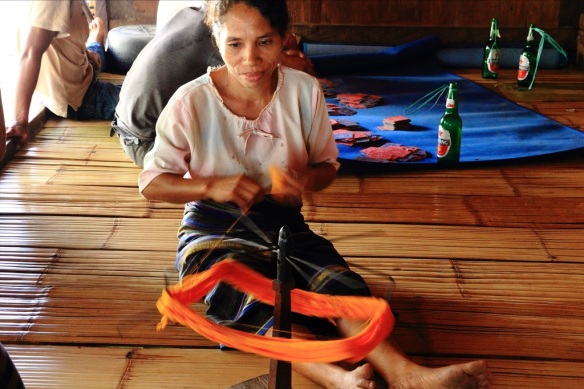
So, I did my due diligence and paid a visit to Ubud.
Ubud was made famous by “Eat Pray Love,” the widely popular and critically scorned Elizabeth Gilbert tome that launched a thousand female midlife crises. This small Balinese town is set among the rice paddies of the island’s Gianyar Regency, and it’s really only a brief drive from South Bali — although the grinding, construction-driven traffic of the island during the midday can make it something of a longer haul. I reached it easily from Sanur by way of the aged but trusty Perama shuttle bus, for the princely sum of $5. (50,000 IDR).
Bali’s cultural capital, Western artists and culture vultures arrived on the scene in Ubud in the early 20th century, working with local Balinese talent to open up interesting museums, fund artist training, and attract more tourists to the region. Thanks to what is often referred to as That Goddamn Book, in certain snobbish Asian expat circles (shout-out to my homies!), Ubud has recently become a magnet for upscale and spiritually ferklumpt tourists who categorically scorn the frivolity of Kuta and the quiet beachiness of Sanur.
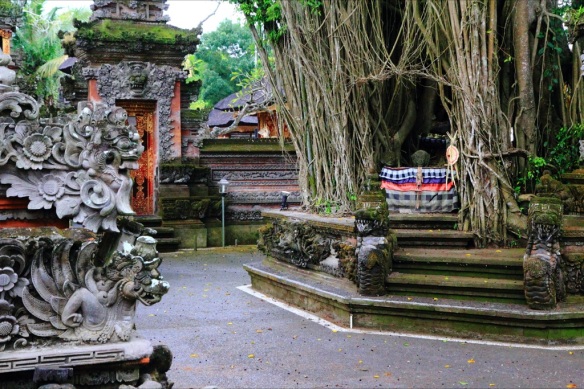
They don’t want to lounge on a sun-kissed beach or dance to House music until they pass out in an alley somewhere from an overdose of E: no, they want to find themselves. And preferably a dark and handsome Brazilian stranger with access to a trust fund as well, if he’s there to be found.
So I was amused to discover that all those pleasingly bitchy stories about an onslaught of hopeful looking women in yoga pants in Ubud were true.
There they were, padding down Ubud’s streets in their Om Shanti Om tank-tops and Ganesha print pants, carrying shopping bags packed chock full of sensible organic fibers and locally produced lemongrass soap. There they sat, in a Westernized cafe offering broccoli quiche and frozen sugary coffee drinks, trying to look wistful and mysterious just in case an Exotic Brazilian Stranger caught their eye from across the room. They had stepped from the pages of Gilbert’s book: I wondered if they felt satisfied by the reality of the place, which is both green and full of temples but remains un-sanitized Indonesia.
Largely missing from the scene were visiting men, who seemed to wash up in Ubud in the company of their blissful looking wives or girlfriends, trailing a few steps behind and looking sheepish about the whole thing. A few rather nerdy looking young male tourists clomped around in cargo pants and t-shirts, their oversized cameras thumping against their hips: perhaps they should stay a while and see if they can recast themselves as suitably exotic for the spiritually-seeking older lady crowd.
The whole place reminded me very much of Sedona, that aggressively New Age town in the red-rocked and ravishingly gorgeous Arizona desert, where a full 50 percent of local businesses will attempt to sell you magic crystals and spiritual healing vision quests conducted by an Actual Goddamn Native American Human Being. I can’t say that I find all this unpleasant or even particularly offensive from an ethical tourism example — for example, I felt none of the fantastic repulsion a wander down Kuta or even some bits of Siem Reap may evoke.
Ubud is in a different sort of mass tourism business than the belly-shirt and grossly offensive bumper sticker hawkers of Kao San Road and Kuta. It caters to the upmarket and educated, people who wish to stroll in leafy gardens full of aesthetically worm-eaten antiques, thinking great thoughts about the turning of the universe, waiting for their Angels and Dharmas to whisper sweet nothings in their ear about Brazilian lovers and drum-circles.
I also find this erudite seeking incredibly annoying, but on the bright side, no one in Ubud was likely to attempt to hump my leg after the inky and inexorable march of nightfall, either. They might just try to sell me on the magikal health benefits of cupping treatments. I can live with that.
 As I quickly determined, there is not a heck of a lot to do in Ubud other than shop for aforementioned pleasingly worm-eaten antiques (real and simulated — where do they get the worms?), sit wistfully in cafes, and take somewhat spendy yoga and mindful Reiki breathing courses.
As I quickly determined, there is not a heck of a lot to do in Ubud other than shop for aforementioned pleasingly worm-eaten antiques (real and simulated — where do they get the worms?), sit wistfully in cafes, and take somewhat spendy yoga and mindful Reiki breathing courses.
I can perhaps see why the twenty-somethings — a group which I tend to conveniently forget I belong to — avoid the place, which lacks Bintang beer, delightfully slutty tanned young things from New Zealand, and three-story tall body paint bubble parties, or whatever the kids do these days.
No, Ubud is for sitting in rice paddies and having deep thoughts — mind the Dengue fever, of course, and watch out for the mosquitoes with the stripey legs.
Even prematurely crotchety me wished for something to happen that would break the considerable earnestness of the place — when really the only excitement I witnessed was two barely-dressed young Australian men discussing travel guides at a high-end bookstore, as if everyone just casually discusses the merits of Lonely Planet in nice bookstores while minimally dressed here in Indonesia.
Noting that the typically quite conservative Indonesian dress code is the exact opposite of what most tourists wear in Ubud might horrify those seeking total cultural integration. I did not do this.
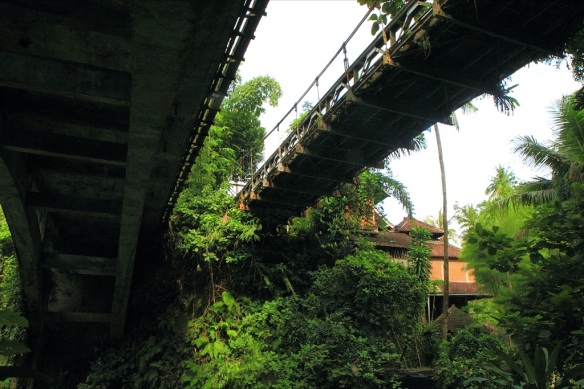 So I wandered through the Bali palace and took some photos of the lovely Hindu architecture, and I wandered through art museums and admired Balinese art (which is worth a considerably more sincere blog post), and mostly I watched other tourists, because I derive any powers I may possess from ill-humored commentary on the foibles of other humans. (It is all that I know). Here is what I saw:
So I wandered through the Bali palace and took some photos of the lovely Hindu architecture, and I wandered through art museums and admired Balinese art (which is worth a considerably more sincere blog post), and mostly I watched other tourists, because I derive any powers I may possess from ill-humored commentary on the foibles of other humans. (It is all that I know). Here is what I saw:
Beatific looking couples in clingy yoga gear wandered through the local Balinese palaces, while others tooled down the streets on scooters, driving entirely too fast for the local custom. Grinning young guys handed out brochures for Spiritual Tours and Bird-watching Trips, while others held up laminated signs advertising Taxi Services.
A few female beggars holding irritated looking children hung out and half-heartedly hustled on the main tourist strip — a far cry from the hardened and swift-handed professionals I’ve grown accustomed to in Phnom Penh and in Saigon. April is off-season in Ubud, and the tourist industry types were succumbing to the humidity, not exactly bringing their A-game. I felt for them.
 I enjoyed a delicious lunch of roasted suckling pig and local vegetables (shredded papaya leaves, cabbage, and green beans) near the Ubud Palace, joined largely by merrily carnivorous Asian tourists happily able to reconcile spiritual awakening with devouring the luscious flesh of an intelligent baby mammal.
I enjoyed a delicious lunch of roasted suckling pig and local vegetables (shredded papaya leaves, cabbage, and green beans) near the Ubud Palace, joined largely by merrily carnivorous Asian tourists happily able to reconcile spiritual awakening with devouring the luscious flesh of an intelligent baby mammal.
I did not feel any burning desire to alleviate my guilt with a bit of tempeh and a carbon buyback afterwards. Mostly I just wanted a nap. For dessert, I had pork rinds.
It began to rain later in the day, and I wandered in the mist across a lovely suspension bridge to a high-end cafe, which played soothing meditation music and overlooked a beautiful jungle canyon, replete with creeping vines and immense and limpid Technicolor butterflies.
The menu offered wine flights, cheese plates, and vegetarian options, but I opted for the cheaper quotidian pleasures of a chilly Bintang, which was served in a smart and expensive looking glass, and poured for me with an elegant head of foam by the waitress. The staff all spoke in low soothing tones, and everyone was wearing some variant on organically pressed white linen.
 As I sat and drank, I leafed though a local tourist magazine that featured insights into Tarot card readings (including the brilliant card-reader inference that a woman’s job working as a bush pilot in Papua New Guinea might be “dangerous”), an article on a sanctuary for orphaned little kitty cats, and a piece of terrible poetry about Living in Harmony With Nature.
As I sat and drank, I leafed though a local tourist magazine that featured insights into Tarot card readings (including the brilliant card-reader inference that a woman’s job working as a bush pilot in Papua New Guinea might be “dangerous”), an article on a sanctuary for orphaned little kitty cats, and a piece of terrible poetry about Living in Harmony With Nature.
I looked out into the jungle canyon, and looked down at the magazine, and I listened as the music in the restaurant shifted from the sounds of the gamelan to the chanting of Tibetan monks. An attractive woman in her 50s was looking through a series of photographs of Balinese antiques on her Macbook Air, and a group of French women were animatedly drinking wine and chain-smoking a corner over. The air was humid and fresh, and birds sang from the rainforest outside.
And in that moment, I realize where I was.
I had stumbled upon the Middle Aged Lady Promised Land.


